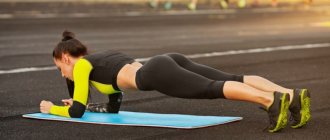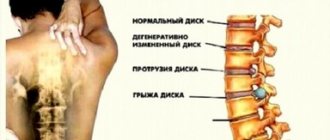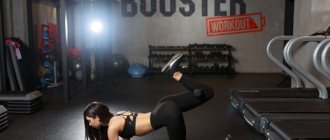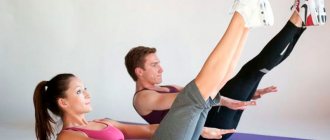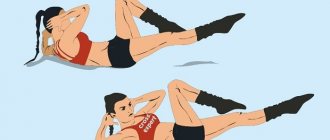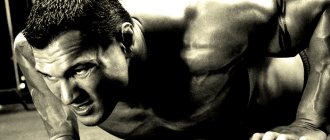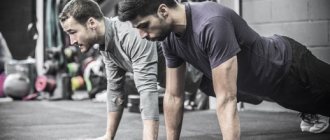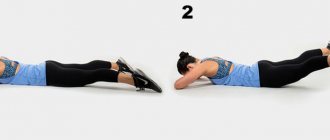The “plank” is a static exercise that is performed on the floor. Typically, the body rests on the forearms/hands during the exercise - it all depends on the specific variety. The “plank” is considered one of the most effective exercises for back problems and excess weight, but is this really so? How to perform the plank exercise, what are its benefits and effectiveness? You will learn about all this from this article.
How to do the plank exercise
General information about the exercise
Let's start with the fact that the “plank” has been one of the classic exercises for training the body in general and the abdomen in particular for many years . The exercise is multifunctional, as it involves many muscle groups, and no special skills or equipment are required to perform it. Suitable not only for advanced athletes, but also for beginners. In a word, a very practical, convenient and effective exercise, and therefore very popular.
Classic “bar” on the elbows
During the “plank”, the muscles of most of the body are involved, it is especially useful in cases where strengthening of the muscle corset is required (if it is strong, it will be able to fully support the spine and back, therefore, the likelihood of injuries to the musculoskeletal system will be noticeably reduced).
Exercise options
How to prepare for the plank exercise
Prices for mats for yoga and fitness
Contraindications for the plank
“The plank is especially good for athletes who want to strengthen their muscle corset,” recommends Alexander Uridin. “But if there are some contraindications, it should be abandoned.” For example, if there are problems with the spine, because if the load is distributed incorrectly, the pain can worsen.
Also, people with umbilical hernias, carpal tunnel syndrome, as well as heart problems and high blood pressure should not do the plank. For women with diastasis (separation of the rectus abdominis muscle after childbirth), a reverse plank (handstand and heel stand facing up) is suitable, but only if the doctor does not prohibit it.
How to do a plank correctly
While doing this, try to pay attention to the points shown in the table below.
Rules for performing the exercise
Table. Rules for performing the exercise.
| Indicators | What to look for |
| Neck, head | It is important to relax them as much as possible, you cannot raise your head, your gaze should be directed to the floor. |
| Breath | You should breathe deeply throughout the entire execution. You need to exhale/inhale slowly, without haste. |
| Hands | They should be crossed or, alternatively, they can be held in front of you. The elbows should be located under the shoulders so as not to put excessive stress on the latter. |
| Feet | Slightly spaced or joined together. The smaller the distance between them, the greater the load on the muscle corset. |
| Small of the back | It must be flat (as if pressed against something), bending/rounding it is prohibited. |
| Stomach | It needs to be pulled in and then pulled towards the ribs. Keep your stomach tucked throughout. Typically, you cannot hold your breath. |
| Legs | Straight, tense, otherwise the entire load will fall only on the lower back. |
| Buttocks | They should also be tensed, they should be at the same level as the back. You cannot lift your buttocks or bend your pelvis. |
Important! The exercise is suitable for people with any level of training, therefore, the duration of the exercise can be changed depending on this parameter. Moreover, if desired, the “bar” can be made more difficult - go down on your knees or raise one arm/leg.
Instructions for performing a full plank
Step 1. Despite the fact that the exercise is very useful, including for posture, it is better to talk to your doctor before performing it to make sure that you do not have any contraindications. If you have previously had injuries to your shoulders, back or abdominal organs, be especially careful!
Step 2. First you need to prepare - start with a position on all fours. Your knees should be placed under your hips and your hands under your shoulders. Then you need to inhale and exhale through your nose.
Step 3. After a deep breath, you need to sit on your feet, while your hands should remain in the same place.
Step 4. After exhaling, you need to assume a downward-facing dog pose (inverted V). To connect the abdominal muscles, push off with your palms from the floor; At the same time, the arms should be rotated so that the elbows “look” at each other.
Technique for performing the plank
“When performing it, a large number of muscle groups work,” says Alexander Uridin. “Using the example of a static plank on straight arms, we’ll look at how to do it correctly.”
- Starting position - lying down. Feet shoulder-width apart and parallel to each other, palms under shoulders, elbows slightly bent. With good physical fitness, you can put your feet together - this will increase the load on the abs.
- In the plank, the neck, back, pelvis and legs should be in a straight line. This means that you cannot lift your pelvis up or, conversely, bend it down. You should also not raise or lower your head. At the same time, the back retains the natural curves of the spine, that is, it does not straighten like a stick.
- To maintain the correct position, tighten your abs, back, buttocks, and pull in your stomach. Look at the floor slightly in front, stretch the top of your head forward, and push your heels back.
- While performing the exercise, imagine that you are standing on a piece of paper, and with your hands and feet you are trying to tear it apart. This will help add stress to the muscles in your arms, back and legs.
- Don't hold your breath - this is a common mistake for beginners. Breathe throughout the entire exercise calmly and measuredly, using the diaphragm (the muscles in the solar plexus area, under the chest).
From the description of the technique it is clear that the bar is suitable not only for losing weight in the abdomen, but also for strengthening the muscles of the whole body and developing correct posture.
Features of increasing execution time
- Exercise daily in several approaches - preferably three to four times (of course, if possible).
- Every five days you need to make progress, that is, increase the number of executions or the duration of the “plank”.
- Combine the plank with other healthy exercises or those prescribed by your doctor.
- If you can withstand the exercise well for several minutes, you can proceed to more complex variations. After all, when muscles get used to the load, work efficiency decreases.
Exercise levels
How long should you hold the plank?
The answer to this question is purely individual. Do the exercise as much as your body allows. Beginners can hold the plank for 15-30 seconds. The main thing is not to increase the duration of execution to the detriment of technique.
Don't do this: 5 basic exercises you're doing wrong
Canadian scientists conducted a study Journal of Strength and Conditioning
, the conclusion of which: a long plank is not as effective as several short approaches. Professor at the University of Waterloo, Dr. Stuart McGill, believes that going for a record and trying to hold the bar for as long as possible is useless for health. However, if the spirit of competition is close to you, you can try to overcome the record of the Dane Tom Hall. He stood in the plank for 4 hours and 28 minutes. Tom has been preparing for the record for a whole year; for the last 4 months he has been completely focused on following his training, nutrition and rest regime.
What about contraindications?
Despite the fact that the exercise described in the article is seemingly harmless, in some cases it is still not worth performing. So, the main contraindications are given below:
- injuries of the upper/lower extremities;
- chronic diseases in the acute stage;
- pregnancy, postpartum period;
- diseases of internal organs;
- excess weight (here it is allowed to perform on your knees, but the duration should not exceed 30 seconds);
- intervertebral hernia;
- hypo- or hypertension.
Hypertension
Contraindications to performing the plank
If you are not able to build your body into a plank and feel comfortable, it is better to postpone it. If it seems to you that the bar is level, but you feel discomfort in your back or neck, you also need to hold off on this exercise.
Another factor is that it is important to maintain even, calm breathing while doing the plank. If shortness of breath begins, this is a sign that it is too early to start the plank.
If static loads are not recommended for you, then the bar is also not recommended. Such contraindications are possible for cardiovascular diseases, problems with blood pressure and vision.
What muscles are involved?
As mentioned earlier, many muscle groups are delayed during exercise. More specifically, the classic “plank” involves the following muscles.
Muscles involved in the classic plank
But with the side “bar” the load is distributed somewhat differently, which can be seen in the image below.
Muscles involved in the side plank
Reverse plank - execution technique
This variation is similar to the classic position, but done in reverse: your body resembles a coffee table. The reverse plank is especially recommended for people with back pain. In this technique, the time that you stand is not so important as the correctness of all actions.
Reverse plank
How to do it: sit on the floor and straighten your legs. Place your palms on the floor and spread your fingers to distribute the load evenly. We tilt the torso back to the floor at an angle of 45 degrees. We place our hands behind the buttocks in line with the shoulders. Raise your torso, legs and butt until they are extended in a straight line. We tense our abdominal muscles. We start with 20 seconds and increase the time. Slowly return to the starting position.
Reverse plank with leg raised
Tip: If you feel your hips starting to sink, stop and do another set after a minute.
The most common mistakes when performing a reverse plank are the head thrown back/chin pressed to the chest/non-compliance with the geometry of the exercise. When the load goes into the hands, the remaining muscles stop working at full strength.
With limb extension
About the benefits of exercise
- Let's start with the fact that the “bar” is ideal for the abdominal muscles, as it covers the entire muscle corset.
- It can be done almost anywhere – all you need is a little free space.
- The exercise is also good because it forces (to one degree or another) almost the entire body to work.
Simplified exercise modifications - The “bar” has many modifications. As they say, for every taste.
- Another exercise is a good prevention of back pain.
- When compared with other exercises intended for the abdomen, the “plank” differs in that it does not have a destructive effect on the lower back.
- If you do this exercise regularly, it will help you maintain a straight back.
- Moreover, regular practice improves balance, which is very useful for everyday life.
- Finally, anyone can do this. Only the time the pose is held will change.
Exercise course for a month
The harm of plank exercises
“The plank is a very good and useful exercise that involves a large number of muscle groups,” says Alexander Uridin, “but at the same time it is quite complex. If performed incorrectly, it can be traumatic.” Let's look at the most popular mistakes that can make the bar harmful.
Let's start with the lower back. By its nature, the human spine is not straight, but with slight bends. These curves serve to cushion the vertebrae during movement. While doing the plank, the natural curves of the spine should be maintained. If the deflection in the lower back is large, then the compression of the lumbar vertebrae increases. Over time, protrusions may appear in this place, which in turn can develop into intervertebral hernias.
Then - the position of the head. Two channels run along the cervical vertebrae, supplying the brain with oxygen. When we stand in a plank and throw our head back or lower it down, we compress these channels, thereby impairing oxygen saturation of the brain.
If a person is overweight or is very weak physically, then the bar should be done from the knees. This will get rid of the negative consequences for the spine, which we mentioned above, and will reduce the pressure on the joints of the legs.
It is not recommended to hold the plank for more than two minutes, as the static position increases the pressure. For the same reasons, people prone to increased blood pressure can only do the dynamic plank.
When to do a plank with caution
There are a number of situations for which the exercise is not contraindicated, but it must be performed extremely carefully.
We recommend that you consult your doctor regarding the following questions:
Postpartum period and cesarean section. In case of successful childbirth, there are no contraindications to the exercise, but starting to do it earlier than a month is prohibited. The load should be gradual, it is better to start with simplified options.
If the birth was complicated, or there was a caesarean section, you definitely need a specialist’s opinion about physical activity.
Post-traumatic and post-operative recovery. When the body is ready for stress again can only be determined through medical procedures. If your doctor has given permission to engage in physical education, you must discuss an individual program with the instructor.
In the listed cases, the exercise is not contraindicated, but it is better to start with easier options, gradually complicating the task.
Improve your overall balance
Have you ever tried to stand on one leg, but it didn't last more than a few seconds? This is because your abdominal muscles are not strong enough to provide the necessary balance . Improving your balance with planks and variations will improve your performance in any sport.
Experience a fast metabolism
The plank is a great opportunity to stimulate the entire body, and if you do it every day, you will burn more calories than other conventional abdominal exercises, such as sit-ups. Muscles strengthened by this exercise daily will burn more fat even while sitting. This is especially important if you have a sedentary job and spend most of the day at the computer.
If you decide to do a 10-minute workout every day before or after work, it will not only speed up your metabolism , but also keep it at a high speed throughout the day. (Yes, even while sleeping)
Benefits of planks for men and women
This is a difficult exercise, even if it doesn't seem like it. It takes little time, but brings a lot of benefits. Anyone can master the technique. It can be used by athletes as part of a training program, and by untrained people who want to maintain tone or get in shape.
For men, the plank is useful:
- in the process of drying the body (static exercises are good for fat burning);
- to increase overall endurance;
- for the harmonious formation of the abs (the muscles of the back and abdomen are worked simultaneously);
- if you need to tighten your stomach;
- in combination with other exercises to maintain fitness.
After a few weeks of training, the 30 second plank will be performed with a smile.
Women , in addition, consider the bar an indispensable assistant:
- when fighting cellulite;
- for shaping the waist and athletic arms;
- to restore abdominal muscles after childbirth (not earlier than a month later, if the birth was without complications);
- for weight loss (if the exercise is used in combination with others and following a diet. Otherwise, the desired effect from the bar cannot be achieved, as from other exercises).
It is noteworthy that to achieve the effect, it is enough to systematically do the plank, alternating its variations. If done correctly and with full dedication, the result will be noticeable within two weeks.
Do a one-minute plank every day for a month: What is the result?
The diary of her experiment was published by wday.ru.
Day 1. Have a bulldozer-like mindset for success. I do my best to do the plank. At the 34th second, the body begins to tremble like an aspen leaf, the muscles shake from tension. Palms exactly under the shoulders, support on all four limbs at once. The elbows need to be slightly bent to remove the load from the joints and direct it to the muscles of the forearm. To reduce the load on the lower back, pull the pubic bone towards you and push the heels back. It's easier that way.
The daily plank stimulates metabolism and generally improves metabolism; its speed remains at a high level throughout the day, even when we sleep. I decided to measure my weight and waist size weekly. At the reference point 64 kg and 73 cm.
Day 2. I stood in the plank for the stated minute, I felt strong tension throughout my body. I was thinking about contraindications, and belatedly I read: planking should not be done during pregnancy or with any back injuries, if you have a tendency to increase blood pressure or have a chronic disease. I did the plank twice a day, morning and evening, I like it. I decided to go beyond the minute limit in the plank and try to add a few seconds every day.
Day 5. The waist has not decreased by a millimeter. Although I began to feel the oblique muscles of the abdomen, an unusual and very pleasant feeling! I really want to take a break. I beat around the bush all day, postponing the plan because of vital matters. I’m seriously thinking about throwing myself on the bed to watch a movie with a soft transition into the arms of Morpheus, but well... 21:15 - plank!
Day 6. I could only stand for a minute and I think I strained my back. Still, I did something wrong. An expert in the field of back health, Anastasia Romanova, recommends that when standing in a plank position, do not bend your lower back, keep your whole body in good shape, and keep a straight line from the top of your head to your heels.
Day 7. The first lost centimeter in the waist. And minus 1.3 kilograms of weight, this is happiness! I feel my abdominal and arm muscles very well. In addition to lower back pain, I’m afraid of getting some other injury, so I’m seriously studying the topic. It turns out that for a long time in the plank with outstretched arms (which is exactly how I stand now), you need strong wrists. I noticed a simple exercise: raising your arms above your head, make “flashlights”, like in kindergarten, while simultaneously bending your hands back and forth. This exercise is great for getting your blood flowing and warming up your joints. Three laps of 10 reps in front of the plank.
Day 11: I feel very confident in the plank. Every day I stand longer, even if only for seconds! I wonder if I add 5 seconds every day, does this mean that in a year I will be doing the plank for 30 minutes...
Day 15. Today is the equator of my plank challenge. I can say for sure that the plank is becoming easier for me, it no longer shakes me like Kashtanka, I feel the muscles of my abs, hips and shoulders that have been holding me level for a minute and a half. The oblique abdominal muscles became clearly visible, but this is a dream! And another minus half a centimeter at the waist. Yes, this is not much in a week, but it could have been plus half a centimeter.
Day 17. To stand longer and strengthen your arms more intensively, you can switch from palms to elbows. I'm getting started! Life hack: I put the phone with “Big Little Lies” in front of my nose, I forget myself and stand still for a few seconds longer.
Day 20. Obsessed with the idea of getting the maximum benefit from my test, I learn from the “search engines” that it is much more effective (and, understandably, harder) to do a plank, alternately rising from the elbows to the palms, and then lowering back to the elbows from straightened arms. At the same time, keep the body motionless.
Photo: from wday.ru
Day 21. Tadaaam! The results of the third week are another minus two centimeters from the waist. I want to run as fast as I can, tearing the finish line with my chest! But there is one thing, the weight has risen.
Day 22. No one in the world is having a harder time right now than I am. I hoped that only yesterday’s first experience of the dynamic plank would be so painful, but even now it’s hellishly difficult for me. Yes, I fell back on the plank time again, but this exercise is definitely more effective and even more fun! Well, the one who walks will master the road.
Day 24. Here they are, the long-awaited minus half a kilo. True, after the evening dynamic plank at 6 pm, I no longer entered the kitchen. By the way, in the morning after an evening fast, I got up with a feeling of incredible lightness and did the plank with great enthusiasm.
Day 26. My husband is surprised and delighted by what is happening, and especially by the fact that I have not left the race, improving my results every day. He said in passing: it seems your butt has become rounder. Have you ever heard a more welcome compliment? After finishing the challenge, I plan to include the bar in my list of daily rituals.
Day 29. Both my 10- and 7-year-old daughters stood up in the plank with me, laughing condescendingly and teasing me. Both cheerleaders have excellent physical fitness, unlike me. By the way, their training plank time (and so far cosmic for the mother) is up to 10 minutes. I have always believed that our children are better and cooler than us, and this is happiness!
Day 30: I can’t believe that tomorrow is the final day of my challenge. It was a long month of work on myself, difficulties, overcoming and, of course, burning pleasure from the process and results. I’ll say right away that there are expectations that were not met. As I can see from my own photos, the plank did not help me get rid of my stomach; I still need to pump up my abs. But this is the coolest work on the relief of the legs, arms, back and buttocks with a real visual result.
Julia before classes and a month after
Day 31. So, exactly one month of daily plank. The conclusions I draw based on my results in seconds, grams and centimeters are:
- The plank time can and should be increased; in a month you can go from zero to one and a half to two minutes, the body is happy and ready for new loads.
- Thanks to the overall improvement in my metabolism, the plank helped me lose 2 kg, although I was not on a special diet. It’s also important that after a minute or a minute and a half in the plank, it’s embarrassing to go and eat a sandwich. Weight before the bar - 64.2, after the bar - 62.2.
- My waist size has decreased by 5 cm! It's cool, noticeable and just encourages you to continue training. And one more result that cannot be measured: I am incredibly proud and pleased with myself. Waist circumference before the strap - 72.5 cm, after - 68.
0 0 votes
Article rating
